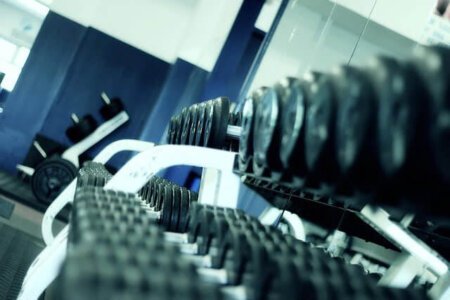Good posture is the natural alignment of your body in a position that puts the least strain on your muscles, joints, and ligaments. It means keeping your body balanced and upright whether you’re standing, sitting, or moving.
WHAT GOOD POSTURE LOOKS LIKE
When standing:
Head is level, not leaning forward or backward
Shoulders are back and relaxed (not hunched)
Chest is open, not caved in
Spine has a natural S-curve (not overarched or flat)
Core is gently engaged
Knees are soft, not locked
Weight is distributed evenly on both feet
When sitting:
Feet are flat on the floor or a footrest
Knees are level with or slightly lower than hips
Back is straight with lower back supported
Shoulders are relaxed, not rounded
Head is aligned over the spine (not pushed forward)
DOES WORKING OUT HELP IMPROVE POSTURE?
Yes—working out can significantly improve posture, especially if your workouts target the right muscles.
HOW EXERCISE HELPS:
Strengthens postural muscles: A strong core (abs, obliques, lower back), glutes, and upper back help hold the body upright.
Improves flexibility: Stretching tight muscles like hip flexors, chest, and hamstrings can reduce postural strain.
Balances muscular development: Many posture issues come from muscular imbalances (e.g., strong chest but weak upper back).
Enhances body awareness: Training with good form reinforces habits of better alignment in daily life.
BEST EXERCISES TO IMPROVE POSTURE:
Strengthening:
Planks and side planks
Rows (dumbbell, cable, or bodyweight)
Reverse flys
Glute bridges
Deadlifts with good form
Stretching:
Chest stretches
Hip flexor stretches
Hamstring and calf stretches
Thoracic spine mobility drills
Posture-specific practices:
Yoga
Pilates
Stability ball or resistance band exercises
CONSISTENTLY COMBINING STRENGTH TRAINING, MOBILITY WORK, AND AWARENESS OF HOW YOU SIT AND STAND THROUGHOUT THE DAY IS KEY TO LASTING IMPROVEMENTS IN POSTURE.
PUSH-UPS AND BENCH PRESS CAN HELP POSTURE, BUT ONLY WHEN BALANCED WITH EXERCISES THAT STRENGTHEN THE BACK AND CORE. ON THEIR OWN, THEY MIGHT ACTUALLY CONTRIBUTE TO POOR POSTURE IF YOU’RE NOT CAREFUL.
🟢 How Push-ups and Bench Press Can Help Posture:
Strengthen the chest, shoulders, and triceps, which are part of your upper body alignment.
Teach proper shoulder positioning, especially when done with good form (shoulders retracted, not shrugged).
Promote core engagement, especially in push-ups, which can support your spine and midsection.
🔴 How They Can Hurt Posture if Overdone or Done Incorrectly:
Overemphasis on chest without back training can pull your shoulders forward → resulting in a hunched or rounded upper back.
Improper form, like flared elbows in push-ups or a collapsed core, can reinforce bad posture habits.
Neglecting upper back, rear shoulders, and spinal stabilizers creates muscle imbalances.
✅ WHAT TO DO FOR POSTURE-FRIENDLY STRENGTH TRAINING:
To make push-ups and bench press part of a posture-improving routine:
Balance chest work with equal or more:
Rows (dumbbell, seated, inverted)
Pull-ups or lat pulldowns
Face pulls or band pull-aparts
Reverse flys
Include core stability:
Planks, bird-dogs, dead bugs
Anti-rotation holds (like Pallof presses)
Stretch tight areas:
Chest, front shoulders, hip flexors
✔️ Yes, push-ups and bench press can help posture—but only as part of a balanced routine.
❌ Doing only chest-focused exercises with no back or core work may worsen posture over time.
To improve posture, you want a workout routine that includes:
CHEST WORKOUTS (PUSH)
These help develop the front of your upper body — important for balance and overall strength, but they need to be paired with back exercises to avoid pulling your shoulders forward.
Examples:
Push-ups
Bench press (flat, incline)
Dumbbell press
Chest dips
Tip: Focus on good form — shoulders back and down, core engaged.
BACK WORKOUTS (PULL)
These are crucial for posture. They pull your shoulders back and help keep your upper body upright.
Examples:
Bent-over rows (barbell or dumbbell)
Lat pulldowns or pull-ups
Seated cable rows
Face pulls
Resistance band pull-aparts
Reverse flys
Tip: Do more pulling than pushing for better postural balance (e.g., 2:1 pull to push).
CORE WORKOUTS (STABILITY + STRENGTH)
A strong core supports the spine and helps you hold a tall, neutral position when standing or sitting.
Examples:
Planks (front and side)
Dead bugs
Bird-dogs
Hanging leg raises
Russian twists
Pallof press
✔️ Tip: Prioritize control and form over doing lots of reps.
MOBILITY & FLEXIBILITY
You can’t have good posture without flexibility — especially in:
Chest (pec stretches)
Hip flexors (lunging stretch)
Hamstrings (forward fold or lying hamstring stretch)
Thoracic spine (foam rolling or mobility drills)
| Focus | Frequency | Examples |
| Chest (Push) | 1–2x/week | Push-ups, bench press |
| Back (Pull) | 2–3x/week | Rows, pull-ups, face pulls |
| Core | 3–4x/week | Planks, dead bugs, bird-dogs |
| Flexibility | Daily or after workouts | Stretching + foam rolling |
TO SIMPLIFY IT, HERE’S A BASIC, EFFECTIVE WORKOUT ROUTINE THAT WILL HELP YOU IMPROVE POSTURE, BUILD MUSCLE, AND DEVELOP A BALANCED PHYSIQUE — ALL WITHOUT NEEDING COMPLEX EQUIPMENT OR ADVANCED TECHNIQUES.
Core Principles:
Include push, pull, and core movements
Focus on form and posture during every rep
Stretch tight areas to stay mobile and upright
BASIC WORKOUT EXERCISES FOR POSTURE AND PHYSIQUE
Push Exercises (Chest, Shoulders, Triceps)
These build the front of your upper body and strengthen pushing power.
Push-ups (standard or incline)
Incline dumbbell press or bench press
Overhead shoulder press (dumbbells or barbell)
Pull Exercises (Back, Rear Shoulders, Biceps)
These correct slouched posture and build your back muscles.
Bent-over rows (dumbbells or barbell)
Pull-ups or assisted pull-ups
Face pulls (cable machine or resistance band)
Reverse flys (light dumbbells or bands)
Core Exercises (Postural Stability)
These keep your spine supported and help you stand and move tall.
Planks (front and side)
Dead bugs
Bird-dogs
Leg raises or hanging leg raises
Pallof press (for anti-rotation strength)
Lower Body (Balance and Alignment)
Your legs and hips also affect posture. Strong glutes and hamstrings are key.
Glute bridges or hip thrusts
Bodyweight squats or goblet squats
Romanian deadlifts (dumbbell or barbell)
Step-ups (onto a bench or sturdy box)
WEEKLY EXAMPLE (3–4 DAYS A WEEK)
Day 1 – Push + Core
Push-ups – 3 sets of 10–15
Overhead press – 3 sets of 8–10
Planks – 3 sets, 30 seconds each
Side planks – 2 sets per side
Day 2 – Pull + Lower Body
Bent-over rows – 3 sets of 8–10
Glute bridges – 3 sets of 15
Reverse flys – 3 sets of 12
Bird-dogs – 2 sets of 10 per side
Day 3 – Full Body (Optional)
Squats – 3 sets of 12
Dumbbell press – 3 sets of 8–10
Pull-ups or assisted pull-ups – 3 sets of 5–8
Dead bugs – 3 sets of 10 per side
Stretch Daily:
Chest, hamstrings, hip flexors, thoracic spine
HERE ARE SOME DEEPER INSIGHTS AND LESS COMMONLY MENTIONED ASPECTS ABOUT IMPROVING POSTURE AND HOW WORKING OUT HELPS:
Posture is a Habit, Not Just a Muscle Issue
Even with strong muscles, if your day-to-day habits involve slouching (at a desk, looking down at a phone, driving hunched), your posture will reflect that. Working out helps by giving your body the strength to maintain proper posture, but you have to consciously practice good posture throughout the day.
Mind-Muscle Connection Really Matters
When you’re working out, focusing on activating the right muscles (especially during rows, planks, and core movements) helps improve your neuromuscular control. This translates into better posture because your body “remembers” how to hold itself properly.
Your Feet and Ankles Affect Posture
Posture begins from the ground up. Weak foot arches, tight calves, or unstable ankles can cause compensations further up the chain — like knees collapsing inward or an anterior pelvic tilt. Barefoot training or foot-strengthening drills can help your alignment.
Posture Includes Movement, Not Just Stillness
Posture isn’t just about sitting or standing straight — it also refers to how you move. A person might stand tall but move with poor mechanics. Functional exercises that mimic real movement patterns (like lunges, carries, and deadlifts with good form) help you move better, not just stand straighter.
Breathing Patterns Influence Posture
Shallow chest breathing (common with stress or poor posture) can tighten the neck and shoulders and weaken deep core muscles. Practicing diaphragmatic breathing (belly breathing) can support your spine and reduce postural tension. Many posture-focused trainers now teach proper breathing as part of posture correction.
Carrying Too Much Tension Can Affect Posture
If you carry emotional stress in your shoulders, neck, or jaw, this often shows up physically — with shrugged shoulders or forward-head posture. While workouts help by relieving stress, things like stretching, yoga, or even breathwork can help release muscular tension for a more relaxed, natural posture.
Posture Can Affect Mood and Confidence
Studies show that better posture leads to:
Increased energy
Better confidence
Lower stress levels
Even improved memory and focus
In other words, the physical benefits of posture have mental and emotional ripple effects.
Consistency is More Important Than Intensity
You don’t need to lift heavy or spend hours in the gym to improve posture. Consistent, intentional movement and posture-friendly exercises done regularly are what lead to lasting changes. Daily posture checks, mobility work, and light strength training go a long way.
Improving posture is about more than just standing up straight—it’s a combination of daily habits, muscle balance, body awareness, and consistent effort. While working out plays a critical role in building the strength and stability needed to maintain good posture, the real transformation happens when you combine that physical training with conscious posture practice throughout your day.
Whether you’re sitting at a desk, walking, lifting weights, or stretching, being mindful of your alignment builds the foundation for lasting improvement.
The beauty of posture-focused fitness is that it doesn’t require perfection or high-level athleticism. With a simple mix of chest, back, core, and mobility exercises, along with regular stretching and breathing awareness, anyone can make significant progress. It’s not about doing everything at once—it’s about making small, consistent adjustments that, over time, re-train your body to move and hold itself with strength and grace.
Ultimately, good posture improves more than your physical appearance—it supports your energy, confidence, and overall well-being. When your body moves efficiently and holds itself upright without strain, everything from breathing to focus to emotional resilience gets a boost. Commit to the process, stay consistent, and you’ll find that strong posture not only looks better, but it feels better too.
TO DIVE DEEPER INTO EVERYTHING WE DISCUSSED ABOUT POSTURE AND HOW WORKING OUT SUPPORTS IT, HERE ARE SOME TRUSTED AND INFORMATIVE SOURCES WHERE YOU CAN LEARN MORE:
1. Mayo Clinic – Posture & Core Health
- Offers clear, medically-reviewed explanations on good posture, back health, and exercises that help.
- Website: www.mayoclinic.org
2. American Council on Exercise (ACE)
- ACE has in-depth articles, videos, and expert advice on posture, muscular imbalances, and fitness programming.
- Website: www.acefitness.org
3. National Academy of Sports Medicine (NASM)
- A go-to source for understanding corrective exercise and posture-focused strength routines.
- Website: www.nasm.org
4. Harvard Health Publishing
- Offers science-based insights on posture, body mechanics, and related exercises from Harvard Medical School.
- Website: www.health.harvard.edu
5. YouTube – Posture-Focused Physical Therapists & Trainers
Search for channels run by licensed professionals such as:
- Bob & Brad (Physical therapists with simple, effective advice)
- Athlean-X (Strength coach Jeff Cavaliere focuses on posture and performance)
- Strength Side (Focuses on mobility and posture improvement through bodyweight training)
6. Books
- “Becoming a Supple Leopard” by Dr. Kelly Starrett – Deep dive into movement mechanics, mobility, and posture.
- “Deskbound” by Starrett, Starrett, and Cordoza – Specifically tackles posture for those who sit a lot.
- “The New Rules of Posture” by Mary Bond – A body-awareness-based approach to posture.
7. Apps & Tools
- Upright GO (wearable posture trainer)
- Posture Reminder Apps for desktops or mobile devices (like Posture Reminder or Stretchly)
- Yoga or Pilates Apps – These often emphasize spinal alignment and posture-friendly movement.


















